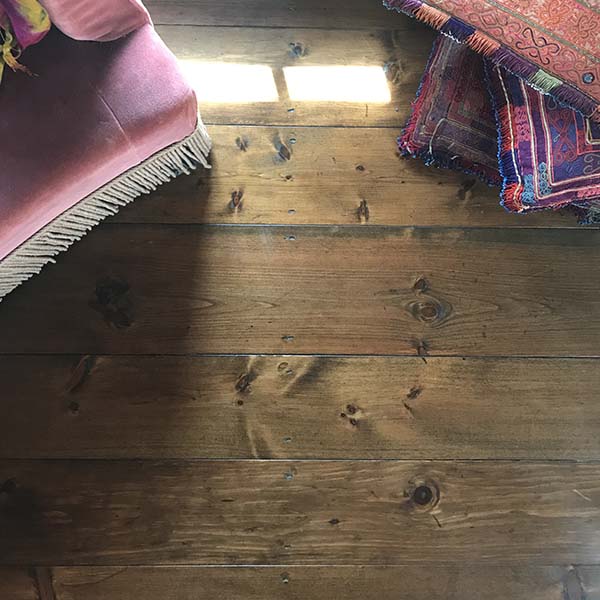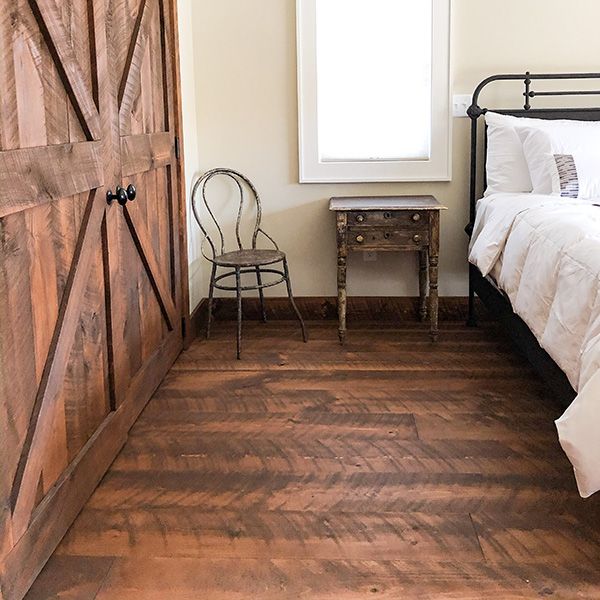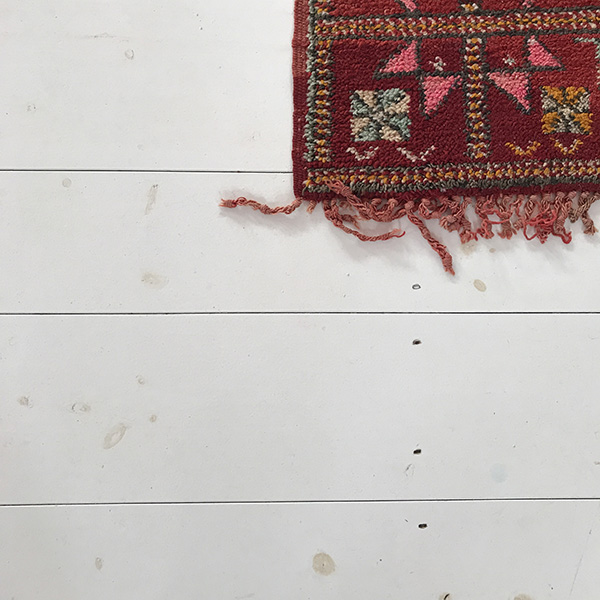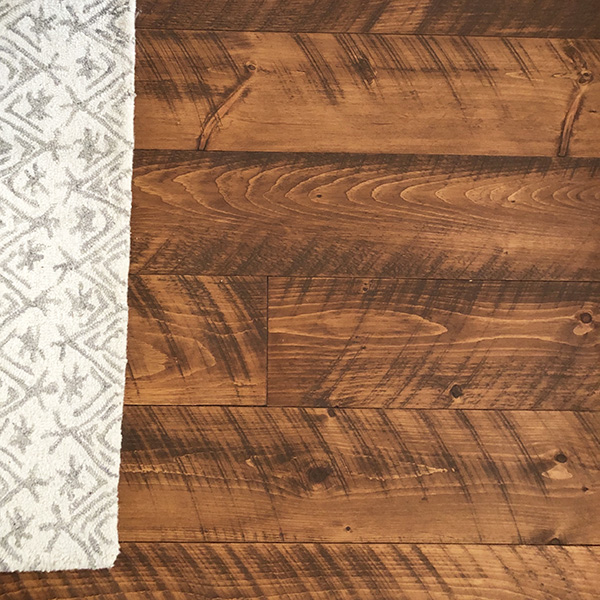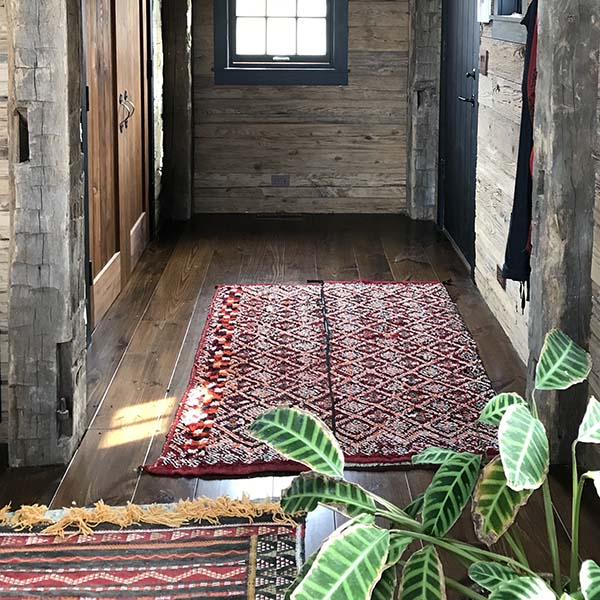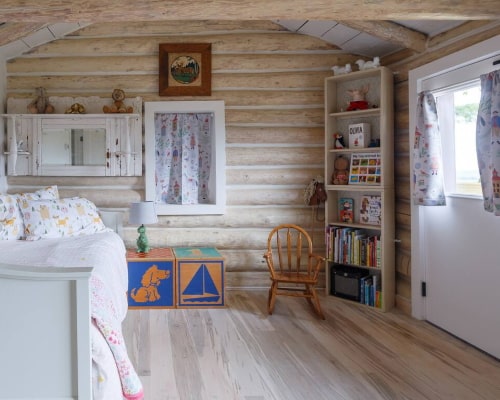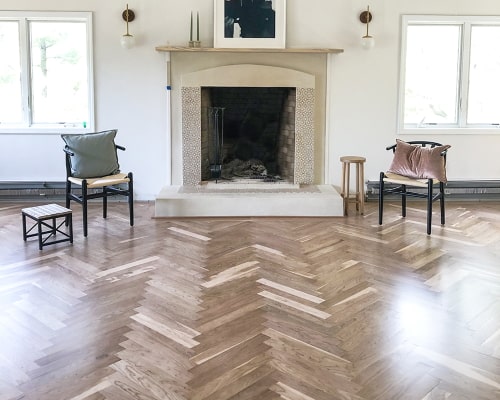Knotty Pine
Hailed for its distinct character and rustic charm, knotty pine is a beloved choice among artisans, builders, and homeowners. Derived from the heart of pine trees, it boasts beautiful, naturally occurring knots that vary in size and shape, imbuing each piece with a unique personality. Rich in history and exuding a warm, inviting aura, knotty pine wood is the quintessential material for creating cozy, cabin-inspired interiors, handcrafted furniture, and timeless architectural features.
Let us Pre-finish Your Flooring!
Connect With UsDescription
- Specie: Eastern White Pine
- Janka Rating: 380
- Widths: 2 1/2 ft
- Lengths: 16ft max
- Grade: Knotty
- Kiln Dried: Absolutely!
- Lumber Source: new wood harvested using responsible forestry practices in NYS whenever possible
- Coating Options: available uncoated and pre-coated, custom colors available: VOC free oils, stains, tongue oils, etc.
- Character: occasional small knots, variation in color and grain pattern Texture: smooth
FAQS
The Janka Hardness Test measures how many pounds of force it takes to embed a .444” steel ball halfway into a piece of wood. This is helpful in determining if a wood specie is suitable for flooring. Harder wood species have higher numbers. Red Oak is our industry-standard for comparing different species. It has a Janka rating of 1290. Most hardwoods and many types of softwood are suitable for use as flooring, especially with proper install, coatings, and maintenance. Please note that all wood will dent with a forceful enough impact.
An example from Hypertextbook.com:
"Humans will only have one foot on the ground while walking. Estimate that the area of the heel on a man's shoe is 10in². When he walks, a 200 lb. man exerts 20 psi because the weight is supported momentarily by the heel. A 100 lb. woman exerts many more psi when she wears heels. Depending on the area of the heel, she can exert as much as 1600 psi under a 'stiletto heel' ¼ inch on a side. This explains why people with wood floors don't want women walking on them in high heels.”
We believe in solid wood flooring because we’ve witnessed how well it performs, especially when compared to engineered wood flooring. We only mill solid wood flooring.
When making solid wood flooring lumber comes straight from the tree, and then it is milled into your flooring. Simple right? Engineered wood flooring is made of layers. Generally, the base layer is made of wood particles bonded together with glue. The top layer is a thin piece of wood affixed to the base with adhesive.
Solid wood flooring is 100% wood. There are no chemical additives that will off-gas into your home. The top layer can’t de-laminate or de-bond because it has naturally bonded itself together. Manufacturing shortcomings such as areas of missing glue or low bonding pressure can’t affect solid wood. Sometimes engineered flooring has a tongue that doesn’t match the color of the face of the flooring. So, when the floorboards gap, a plywood colored strip shows between the seams.
Our solid wood flooring can be repaired, sanded and re-finished many times due to an extra thick wear layer (5/16” thick or 15.8 mm), unlike engineered flooring. Typical engineered flooring has a 2 – 4 millimeter wear layer. A nickel is 2 mm thick.
Solid wood flooring can last over 100 years when cared for properly. It adds value to homes. It reduces allergens (compared to carpet) and increases air quality (compared to engineered).
Many engineered wood flooring products have limitations on board lengths (6’ and shorter for example). This creates a choppy overall effect with lots of seams. This is not the case with our solid wood floors. Often, our average board length is 6’-8’.
While there are circumstances where engineered wood may perform better, please be aware that there is a class-action lawsuit against one of the largest suppliers of engineered wood flooring in the United States. Dangerous levels of carcinogenic formaldehyde emit from this flooring. Please do your homework and choose carefully.
- Wood is sterilized and insects are killed during this process. While some reclaimed wood is quite dry we must take this step to ensure that insects will not be moving into your home.
- Kiln dried wood absorbs coatings better. In fact, coatings will last longer.
- Kiln drying wood decreases shrinkage and movement in service. Non-kiln dried wood may shrink and de-form as it loses moisture from its environment.
Decreased weight makes for easier handling and installations.
Note: There is no way to prevent wood from absorbing water and releasing water into its environment. Trees are designed to drink water and this property can’t be completely diminished. Kiln drying is an important step in reducing (not eliminating) movement in your floors.
Upon inquiry, we will provide a written quote for approval and acceptance. Please review the quote carefully and verify that all quantities, species, sizes are what you ordered. The written quote must be signed and the required deposit must be received by Excelsior to initiate the order.
Be sure to properly store and acclimate your siding and decking at the job site.
Proper storage of your exterior wood products is critical for a successful installation. Understanding your job site conditions and how they impact wood products is essential in determining proper storage methods.
The wood should be kept dry. The goal is to keep the product from direct exposure to the elements (sun, rain, sleet, snow, etc.) prior to installation while allowing it to acclimate. Be advised that your product must also be protected from the ground below and its detrimental effects of moisture infiltration.
Failure to properly store your material can and likely will result in the manifestation of many damaging effects. Proper on-site storage is not Excelsior Wood Products’ responsibility.
Here are some tips to consider that could help keep your siding and decking in good condition prior to installation:
- Keep the wood products elevated off the ground a minimum of 4″-6″ on a flat surface.
- Place a moisture barrier, like a tarp, on the ground beneath the pack.
- Cover the unit with a moisture barrier. Elevate the center so water doesn’t pool on the top.
- Do not completely seal the bundle. Air should be able to circulate fully around and throughout the stack. The goal is for the material to acclimate to the temperature and humidity of the job site. Generally speaking, in our region most wood products are ready to install when they are below a 15% moisture content.
- For best air circulation and acclimation sticker each layer.
- If your siding or decking is pre-coated be careful that you do not get sticker marks on the faces of the boards. In this case, you could stack a layer face to face leaving the slip sheets (thin plastic sheets separating the boards) between the boards so they do not adhere together causing sticking and peeling. Be sure to protect the exposed faces of the boards, even if it is not pre-coated.
In any case, if your order has slip sheets, we encourage you to leave these between the boards until you are ready to install. They will help the boards from sticking together and peeling off the coatings.
The Janka Hardness Test measures how many pounds of force it takes to embed a .444” steel ball halfway into a piece of wood. This is helpful in determining if a wood specie is suitable for flooring. Harder wood species have higher numbers. Red Oak is our industry-standard for comparing different species. It has a Janka rating of 1290. Most hardwoods and many types of softwood are suitable for use as flooring, especially with proper install, coatings, and maintenance. Please note that all wood will dent with a forceful enough impact.
An example from Hypertextbook.com:
"Humans will only have one foot on the ground while walking. Estimate that the area of the heel on a man's shoe is 10in². When he walks, a 200 lb. man exerts 20 psi because the weight is supported momentarily by the heel. A 100 lb. woman exerts many more psi when she wears heels. Depending on the area of the heel, she can exert as much as 1600 psi under a 'stiletto heel' ¼ inch on a side. This explains why people with wood floors don't want women walking on them in high heels.”
We believe in solid wood flooring because we’ve witnessed how well it performs, especially when compared to engineered wood flooring. We only mill solid wood flooring.
When making solid wood flooring lumber comes straight from the tree, and then it is milled into your flooring. Simple right? Engineered wood flooring is made of layers. Generally, the base layer is made of wood particles bonded together with glue. The top layer is a thin piece of wood affixed to the base with adhesive.
Solid wood flooring is 100% wood. There are no chemical additives that will off-gas into your home. The top layer can’t de-laminate or de-bond because it has naturally bonded itself together. Manufacturing shortcomings such as areas of missing glue or low bonding pressure can’t affect solid wood. Sometimes engineered flooring has a tongue that doesn’t match the color of the face of the flooring. So, when the floorboards gap, a plywood colored strip shows between the seams.
Our solid wood flooring can be repaired, sanded and re-finished many times due to an extra thick wear layer (5/16” thick or 15.8 mm), unlike engineered flooring. Typical engineered flooring has a 2 – 4 millimeter wear layer. A nickel is 2 mm thick.
Solid wood flooring can last over 100 years when cared for properly. It adds value to homes. It reduces allergens (compared to carpet) and increases air quality (compared to engineered).
Many engineered wood flooring products have limitations on board lengths (6’ and shorter for example). This creates a choppy overall effect with lots of seams. This is not the case with our solid wood floors. Often, our average board length is 6’-8’.
While there are circumstances where engineered wood may perform better, please be aware that there is a class-action lawsuit against one of the largest suppliers of engineered wood flooring in the United States. Dangerous levels of carcinogenic formaldehyde emit from this flooring. Please do your homework and choose carefully.
- Wood is sterilized and insects are killed during this process. While some reclaimed wood is quite dry we must take this step to ensure that insects will not be moving into your home.
- Kiln dried wood absorbs coatings better. In fact, coatings will last longer.
- Kiln drying wood decreases shrinkage and movement in service. Non-kiln dried wood may shrink and de-form as it loses moisture from its environment.
Decreased weight makes for easier handling and installations.
Note: There is no way to prevent wood from absorbing water and releasing water into its environment. Trees are designed to drink water and this property can’t be completely diminished. Kiln drying is an important step in reducing (not eliminating) movement in your floors.
Upon inquiry, we will provide a written quote for approval and acceptance. Please review the quote carefully and verify that all quantities, species, sizes are what you ordered. The written quote must be signed and the required deposit must be received by Excelsior to initiate the order.
Be sure to properly store and acclimate your siding and decking at the job site.
Proper storage of your exterior wood products is critical for a successful installation. Understanding your job site conditions and how they impact wood products is essential in determining proper storage methods.
The wood should be kept dry. The goal is to keep the product from direct exposure to the elements (sun, rain, sleet, snow, etc.) prior to installation while allowing it to acclimate. Be advised that your product must also be protected from the ground below and its detrimental effects of moisture infiltration.
Failure to properly store your material can and likely will result in the manifestation of many damaging effects. Proper on-site storage is not Excelsior Wood Products’ responsibility.
Here are some tips to consider that could help keep your siding and decking in good condition prior to installation:
- Keep the wood products elevated off the ground a minimum of 4″-6″ on a flat surface.
- Place a moisture barrier, like a tarp, on the ground beneath the pack.
- Cover the unit with a moisture barrier. Elevate the center so water doesn’t pool on the top.
- Do not completely seal the bundle. Air should be able to circulate fully around and throughout the stack. The goal is for the material to acclimate to the temperature and humidity of the job site. Generally speaking, in our region most wood products are ready to install when they are below a 15% moisture content.
- For best air circulation and acclimation sticker each layer.
- If your siding or decking is pre-coated be careful that you do not get sticker marks on the faces of the boards. In this case, you could stack a layer face to face leaving the slip sheets (thin plastic sheets separating the boards) between the boards so they do not adhere together causing sticking and peeling. Be sure to protect the exposed faces of the boards, even if it is not pre-coated.
In any case, if your order has slip sheets, we encourage you to leave these between the boards until you are ready to install. They will help the boards from sticking together and peeling off the coatings.

